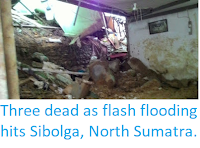Twenty nine people have died in a series of flash floods and landslides in North Sumatra associated with the onset of the Northeast Monsoon, on Friday 12 October 2018. The worst incident occurred in the village of Muara Saladi in Mandailing Natal District, where a landslide hit an Islamic School sweeping away 29 pupils and several teachers. The majority of these were rescued alive, but twelve of the children died. Landslides
are a common problem after severe weather events, as excess
pore water pressure can overcome cohesion in soil and sediments,
allowing them to flow like liquids. Approximately 90% of all landslides
are caused by heavy rainfall. A further twelve people were killed in flash floods elsewhere in Mandailing Natal District, with waters up to two metres deep that swept away seventeen houses and a number of cars. Flash floods are a particular problem in
areas where urban sprawl has resulted in areas where the ground is
covered by non-porous concrete of similar materials, preventing
rainwater from sinking into the soil. In neighbouring Sibolga District a further four people died as landslides destroyed 29 homes and floods hit about a hundred more. In West Sumatra five people including two children were killed in Tanah Datar District, and four in Padang Pariaman and West Pasaman districts.
The remains of an Islamic School in Mandailang District, North Sumatra, destroyed by a landslide on Friday 12 October 2018. Antara Foto/Reuters.
Sumatra
has a wet tropical climate, with a rainy season that lasts from October
to April, when rainfall typically reaches 200-300 mm per month and a
dry season from May to September, when rainfall is usually below 200 mm
per month (though the area is never truly dry. This is driven by the
Southeast Asian Monsoon Seasons, with the Northeast Monsoon driven
by winds from the South China Sea fuelling the wetter rainy season and the Southwest Monsoon driven by winds from the southern Indian Ocean the drier dry season. Such a double Monsoon Season is common
close
to the equator, where the Sun is highest overhead around the equinoxes
and lowest on the horizons around the solstices, making the solstices
the coolest part of the year and the equinoxes the hottest.
The winds that drive the Northeast and Southwest Monsoons in Southeast Asia. Mynewshub.
Monsoons
are tropical sea breezes triggered by heating of the land during the
warmer part of the year (summer). Both the land and sea are warmed by
the Sun, but the land has a lower ability to absorb heat, radiating it
back so that the air above landmasses becomes significantly warmer than
that over the sea, causing the air above the land to rise and drawing in
water from over the sea; since this has also been warmed it carries a
high evaporated water content, and brings with it heavy rainfall. In the
tropical dry season the situation is reversed, as the air over the land
cools more rapidly with the seasons, leading to warmer air over the
sea, and thus breezes moving from the shore to the sea (where air is
rising more rapidly) and a drying of the climate.
Diagrammatic representation of wind and rainfall patterns in a tropical monsoon climate. Geosciences/University of Arizona.
See also...
Follow Sciency Thoughts on Facebook.









